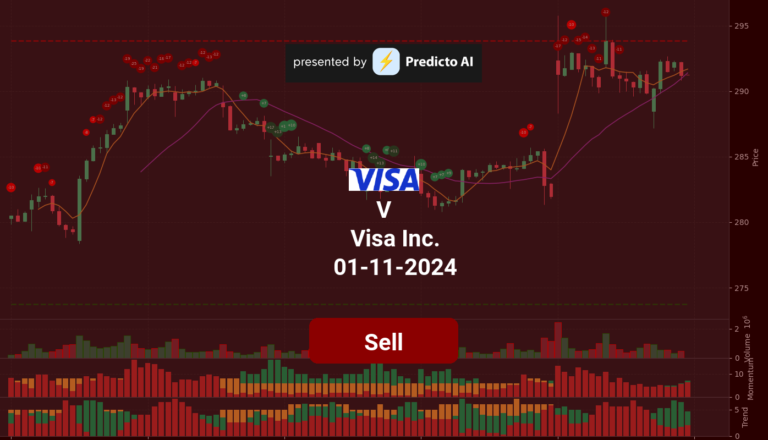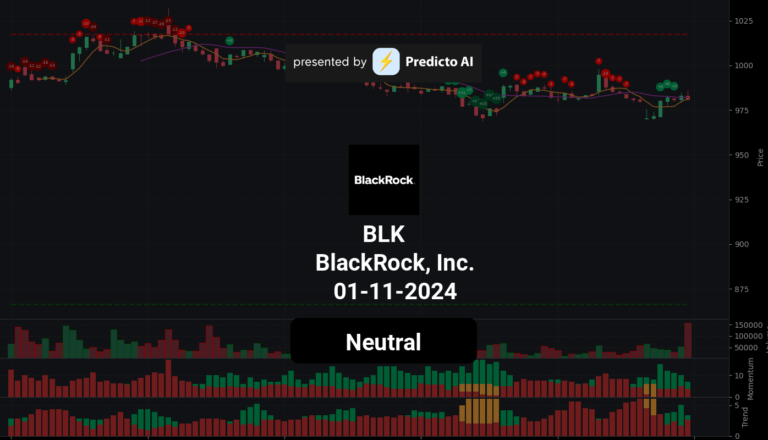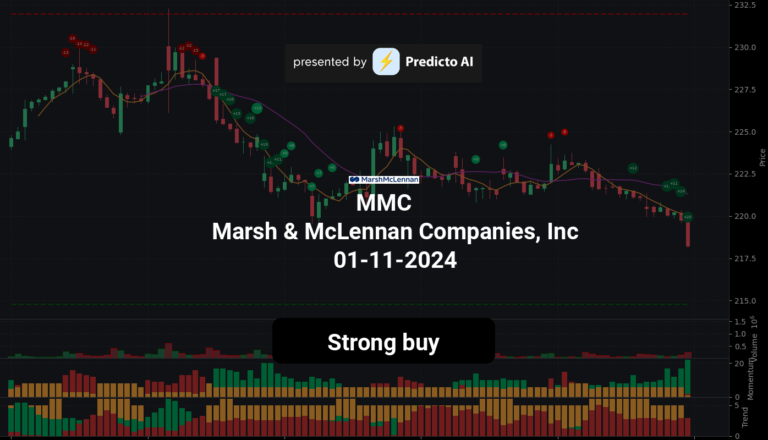BAX Stock Analysis: A Mixed Outlook Ahead!
🔴 Recommendation: BAX is currently rated as a Strong Sell, with significant concerns highlighted by 10 negative indicators compared to just 6 positives.
📈 Key Highlights:
Financial Performance: Recent net income stands at a troubling -$314 million, raising alarms about profitability.
Revenue Growth: Total revenue reached $3.81 billion, reflecting a year-over-year growth of 6.12%, indicating some stability in sales.
Valuation Metrics: The forward P/E ratio of 11.66 suggests potential undervaluation relative to the market.
⚠️ Caution Flags:
High Debt Levels: Average net debt is concerning at $11.52 billion, which could impact financial flexibility.
Negative Profit Margins: The net profit margin is alarmingly low at -8.24%, signaling challenges in converting revenue into profit.
As we delve deeper into the analysis, we will explore the price trends, technical indicators, financial health, and market sentiment surrounding BAX to provide a comprehensive overview for investors. Stay tuned for more insights! 👇
BAX Price Analysis

| Positive Momentum Signals | Negative Momentum Signals | Hold Momentum Signals |
|---|---|---|
|
|
|
| Positive Trend Signals | Negative Trend Signals | Hold Trend Signals |
|---|---|---|
|
|
|
BAX stock presents a complex financial picture, characterized by both positive and negative indicators. Currently, the stock is rated as a strong sell, reflecting significant concerns despite some bullish signals.
On the positive side, there are indications of potential reversal and bottoming out, as evidenced by the WaveTrend showing bullish divergence and being oversold. Additionally, the stock is trading above the 50-day EMA, which suggests a bullish trend that is strengthening. The On-Balance Volume (OBV) is also increasing, supported by high volume, indicating strong buying interest. Furthermore, the price is above the middle band of the Bollinger Bands, suggesting an uptrend, although caution is warranted due to overbought conditions.
However, the negative indicators cannot be overlooked. The stock is currently below the 200-day EMA, indicating a bearish trend that is also strengthening. The StochRSI is overbought, and the stock is positioned closer to resistance levels, which raises concerns about potential price corrections.
In summary, while BAX shows some positive momentum and trend indicators, the overarching bearish signals and the strong sell recommendation suggest that investors should exercise caution. It may be prudent to consider a sell or hold strategy until clearer signs of recovery and stability emerge in the stock’s performance.
BAX Fundamental Analysis
BAX’s recent financial performance presents a mixed picture, raising several concerns about its overall health. The company reported a negative net income of $-314 million for the most recent period, which is alarming and indicates significant challenges in achieving profitability. Furthermore, the year-over-year decline in net income suggests ongoing difficulties in maintaining a profitable operation.
On a more positive note, BAX achieved a total revenue of $3.81 billion, reflecting a year-over-year growth of 6.12%. This moderate growth indicates that the company is capable of increasing its sales, which is a positive sign amidst the profitability challenges. However, the operating margin is exceptionally high at 100.00%, yet the net profit margin is concerningly low at -8.24%. This discrepancy highlights the company’s struggle to convert its revenue into actual profit.
The company’s financial structure raises additional red flags. With an average net debt of $11.52 billion, BAX faces potential challenges regarding financial flexibility and its ability to service this debt. The net interest income is also negative at $-85 million, indicating that the company is paying more in interest than it earns from its assets, further straining its financial position.
From a valuation perspective, BAX’s forward P/E ratio of 11.66 suggests that the stock may be undervalued compared to the broader market, while the price-to-sales ratio of 1.25 indicates that the stock is reasonably priced and not overvalued. These metrics could present an opportunity for investors if the company can address its profitability issues.
In terms of growth and profitability, the revenue growth of 6.12% is a positive indicator, yet the net profit margin of -8.24% raises significant concerns about the company’s ability to generate profits after accounting for expenses. Additionally, the average dilution earnings per share is negative at $-314 million, reflecting the impact of share-based compensation on earnings.
Shareholder information shows a stable base with an average ordinary shares outstanding of 508 million. However, the presence of average treasury shares at 175 million could indicate management’s confidence in the stock but also raises questions about cash reserves.
On the balance sheet, the current ratio of 1.23 suggests a healthy liquidity position, allowing the company to cover its short-term liabilities. However, the debt-to-equity ratio of -3.12 indicates a high level of leverage, which could be risky depending on the industry context. The average tangible book value being negative at $-4.86 billion is another sign of financial distress.
Cash flow analysis reveals a positive net cash from financing activities of $5.35 billion, indicating that the company is raising capital for growth or debt reduction. The average capital expenditures of $678 million suggest ongoing investment in growth and expansion, which is a positive sign for future prospects. However, the lack of explicit mention of free cash flow should be monitored closely for operational sustainability.
In summary, while BAX shows some positive indicators such as revenue growth and reasonable valuation metrics, the significant challenges posed by negative net income and profit margins raise serious concerns about the company’s financial health and future profitability. Investors should approach BAX with caution and consider the potential risks before making any investment decisions.
Financial Health
🔴 Net Income for the most recent period was negative at $-314 million, raising concerns about the company’s profitability.
🔴 Year-over-year net income decreased, indicating potential challenges in maintaining profitability moving forward.
🟢 Total Revenue for the most recent period was $3.81 billion, with a year-over-year revenue growth of 6.12%, suggesting moderate growth.
🔴 Operating Margin is exceptionally high at 100.00%, but the net profit margin is low at -8.24%, indicating issues in converting revenue into profit.
🔴 Average Net Debt is high at $11.52 billion, which could impact financial flexibility and debt servicing capabilities.
🔴 Net Interest Income is negative at $-85 million, suggesting the company is paying more in interest than it earns on its assets.
Valuation
🟢 Forward P/E ratio is 11.66, indicating potential undervaluation compared to the market.
🟢 Price-to-Sales ratio is 1.25, which is reasonable and suggests the stock may not be overvalued.
Growth and Profitability
🟢 Revenue Growth of 6.12% is positive, indicating a stable growth trajectory.
🔴 Net Profit Margin of -8.24% raises concerns about the company’s ability to generate profits after expenses.
🔴 Average Dilution Earnings per share is negative at $-314 million, indicating significant share-based compensation impacts.
Shareholder Information
🟢 Average Ordinary Shares Outstanding is 508 million, suggesting a stable shareholder base.
🔴 Average Treasury Shares at 175 million could indicate management’s confidence but also raises concerns about cash reserves.
Income Statement
🔴 Net Income is negative at $-314 million, indicating challenges in profitability.
🟢 Total Revenue of $3.81 billion with a growth of 6.12% suggests a positive trend in sales.
🔴 Operating Margin is high at 100.00%, but the negative net profit margin is concerning.
Balance Sheet
🟢 Current Ratio of 1.23 indicates a healthy liquidity position, suggesting the company can cover its short-term liabilities.
🔴 Debt-to-Equity Ratio of -3.12 suggests a high level of leverage, which may be risky depending on the industry.
🔴 Average Tangible Book Value is negative at $-4.86 billion, indicating financial distress.
Cashflow
🟢 Positive net cash from financing activities at $5.35 billion indicates capital raising for growth or debt reduction.
🟢 Average Capital Expenditures of $678 million suggests investment in growth and expansion.
🔴 Free Cash Flow is not explicitly mentioned but should be monitored for operational sustainability.
Overall, while there are some positive indicators such as revenue growth and a reasonable valuation, the negative net income and profit margins raise significant concerns about the company’s financial health and future profitability.
BAX News Analysis
BAX News: A mixed outlook for investors.
The news surrounding Baxter International Inc. (BAX) presents a mixed outlook for investors. While there are concerns regarding the impact of Hurricane Helene on the medical supply chain, there are also discussions about the company’s value compared to competitors. Investors should weigh these factors carefully.
🔴 The article titled “Running on Ice: Hurricane Helene came for the medical supply chain in a bad way” highlights the disruptions caused by Hurricane Helene, which could negatively impact BAX’s supply chain and operations.
🟢 In contrast, the article “BAX or LMAT: Which Is the Better Value Stock Right Now?” suggests that BAX is being compared favorably against another competitor, indicating potential value for investors.
🟢 Another article, “Should Value Investors Buy Baxter International (BAX) Stock?” discusses the potential for BAX as a value investment, which could attract interest from value-focused investors.
🔴 However, the overall sentiment regarding the supply chain issues may overshadow these positive comparisons, leading to uncertainty in the stock’s performance.
🟢 The upcoming conference call for third-quarter financial results could provide more clarity on the company’s performance and future outlook, which may influence investor sentiment.
BAX Holders Analysis
The financial health of BAX presents a mixed outlook for the next month. While there are positive indicators from institutional ownership, the low insider ownership and lack of recent insider purchases raise some concerns.
🟢 BAX has a **high institutional ownership** at **91.90%**, indicating strong interest from large investors. This suggests confidence in the company’s long-term prospects and stability.
🔴 However, the **insider ownership is very low at 0.38%**, which may indicate a lack of confidence from company management or a high degree of external control. This could lead to volatility if institutional investors decide to sell.
🟡 The **number of institutional holders is substantial at 1218**, which reflects a diversified ownership structure. This can provide some stability, but it also means that any significant sell-off by these institutions could impact the stock price negatively.
🟡 There have been **no recent insider purchases**, which could suggest that insiders do not see immediate value in buying shares at current levels. This lack of insider buying could be interpreted as a lack of confidence in the stock’s short-term performance.
🔴 The recent insider transactions show a pattern of selling, which could indicate that insiders are cashing out rather than investing further in the company.
BAX Analyst Ratings
The analyst ratings for BAX show a mixed sentiment, with a total of 2 strong buy ratings, 4 buy ratings, 9 hold ratings, 1 sell rating, and no strong sell ratings. This indicates a cautious outlook among analysts. 🟡 Over the past month, the ratings have remained relatively stable, with no significant upgrades or downgrades, suggesting that analysts are uncertain about the stock’s immediate performance.
The recent actions from firms like Citigroup, Goldman Sachs, and JP Morgan maintaining a neutral stance further emphasize this cautious sentiment. 🟢 However, the presence of 4 buy ratings indicates some analysts still see potential for growth.
Given the current analyst ratings and the lack of significant changes in recommendations, it is likely that BAX will experience moderate performance over the next month. The medium confidence level reflects the mixed signals from analysts, suggesting that while there is potential for upside, investors should remain vigilant.
BAX Economic Analysis
Based on the US economic and market data:
🔴 The unemployment rate has increased to 4.3%, up from 4.1% in the previous month, indicating a potential weakening in the labor market. This could lead to reduced consumer spending, which may negatively impact Baxter’s sales in the healthcare sector.
🟡 Retail sales have shown a slight increase to 627,510, but the growth is modest compared to previous months. This suggests that while there is some consumer demand, it may not be strong enough to significantly boost Baxter’s revenues in the short term.
🔴 The recent CPI data indicates inflationary pressures, which could lead to higher operational costs for Baxter. If inflation continues to rise, it may squeeze profit margins, especially in the medical instruments and supplies sector.
🟢 On a positive note, Baxter’s diversified product portfolio and strong presence in the healthcare market may provide some resilience against economic fluctuations. The company’s focus on essential medical products could help maintain steady demand.
Overall, the combination of rising unemployment and inflationary pressures presents challenges for Baxter in the coming month. The stock price may remain relatively stable but could face downward pressure if economic conditions do not improve.
Disclaimer
Investors may consider the AI predictions and news summaries as one factor in their investment decisions alongside their own research and risk tolerance.




